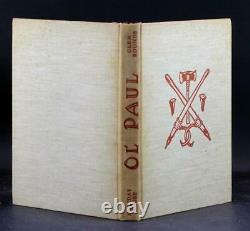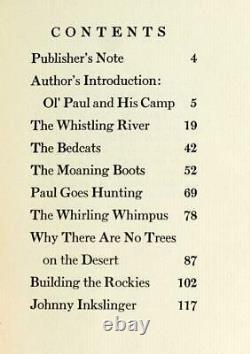Glen Rounds Signed 1st Edition 1936 Ol' Paul The Mighty Logger Paul Bunyan HC DJ













Illustrated with black and white plates. Signed by Glen Rounds on the FFEP.
First Edition/First Printing DJ is missing the spine and has chipping, shelf-wear and rubbing present to the DJ especially around the extremities. Bound in cloth boards with gilt titles present. Boards have light shelf-wear present to the extremities. Text is clean and free of marks.
Ol' Paul, the Mighty Logger is an anthology of ten original Paul Bunyan tall tales: it was written and illustrated by Glen Rounds, and published by Holiday House in 1936. Upon its publication, Kirkus Reviews praised it, saying that there's a harmony about this book -- the telling of familiar episodes from the Paul Bunyan legend, the homespun look of the paper, the virility of the line illustrations.[A] book to read aloud. It was one of the seventeen books selected in the inaugural class of Lewis Carroll Shelf Award recipients in 1958. Glen Rounds Signed 1st Edition 1936 Ol' Paul The Mighty Logger Paul Bunyan HC DJ. Up For Sale Today is. The Mighty Logger Being a True Account of the Seemingly Incredible Exploits and Inventions of the Great Paul Bunyan.
Glen Harold Rounds (April 4, 1906[1] - September 27, 2002[2]) was an American author and illustrator. In a career that exceeded six decades, he wrote and illustrated well over 100 books. He was the recipient of more than 25 literary awards. Glen Rounds was born in a sod house near Wall, South Dakota in 1906, in a region known as the South Dakota Badlands. When he was a year old, he and his family traveled in a covered wagon to Montana, where he grew up on a ranch.During his youth, he worked at many odd jobs, including baker, cook, sign painter, sawmill worker, [6] cowboy, mule skinner, logger, ranch hand, and carnival medicine man. Rounds took an interest in art from a young age, making frequent sketches of characters and scenes from his daily life. He pursued formal training in painting and drawing at the Kansas City Art Institute from 1926 to 1927, and at the Art Students League of New York from 1930 to 1931. During this formative period, he spent a summer touring the Western United States together with Jackson Pollock, a fellow art student, and Thomas Hart Benton, their teacher at the Art Students League. Rounds spent much of the early 1930s visiting publishers in New York City in an attempt to convince editors to give him work as an illustrator.
Vernon Ives, who worked at Holiday House, the publisher that would eventually publish Rounds' first book, later remarked that his initial impression of Rounds was of a young, footloose westerner with a discerning eye, a quick, sketchy style of drawing that had enormous vitality, and a tongue even more facile than his brush. Through these persistent efforts to win the attention of publishers, Rounds unintentionally developed a reputation as a gifted storyteller, to the extent that editors eventually advised him to create an artistic opportunity for himself by writing a story collection that he could also illustrate.
The result was Ol' Paul, the Mighty Logger (1936), an anthology of Paul Bunyan stories that Rounds later admitted he had largely invented. The book appeared to rave reviews: Kirkus Reviews praised the "virility of the [book's] line illustrations" and its "homespun look", summing it up as "a book to read aloud".
After the success of Ol' Paul, the Mighty Logger, Rounds had a steady stream of work, both as an author and illustrator of his own books and as an illustrator for the work of others, for the rest of his life. Rounds published a wide variety of fiction and non-fiction, all of it written for an audience of children and young adults. In The Blind Colt (1941), he introduced the character of Whitey, a young Montana cowboy, who would eventually appear in eleven books published from 1941 to 1963. Yowder, the itinerant sign painter, would be featured in six books published in the 1970s and 1980s.
Many of Rounds' other works focus on his attentive eye for the natural world, including several books that deal with the wildlife and environment of the Great Plains (where he had spent his youth) or of North Carolina (where he settled after the Second World War). Clues to the appeal of Rounds storytelling were given by Pat Parker in Language Arts magazine: Rounds draws children, women, men and the ever-present dogs surrounded by space, suggesting frugality and human frailty in a land of awesome size; at the same time he adds subtle, sly, comic touches for real-life atmosphere. Late in his career, Rounds struggled with arthritic pain in his right arm. In 1989 this condition had grown too severe for him to continue illustrating, so at the age of 83, Rounds taught himself to draw with his left hand, and resumed his work as an illustrator.
Reviewers continued to praise both his writing and his artistry: his last book, Beavers (1999), was praised by a Horn Book reviewer as "a model of how to convey a wealth of information in just a few clear, well-phrased sentences, " and his illustrations were compared to the patient work of a beaver building a dam, seeming "aimless when taken stick by stick or line by line, but wonderfully effective in sum". OUR MISSION STATEMENT: Our goal is to provide the best books for the lowest prices. Thank you for visiting this listing and we hope to see you again soon! Book formats and corresponding sizes. Approximate cover size (width × height).ALL ITEMS ARE DESCRIBED TO THE BEST OF MY ABILITY! ALL ITEMS ARE WRAPPED IN 2 LAYERS OF BUBBLE WRAP AND THEN PLACED INTO A CUSTOM FITTED CARDBOARD MAILER. IF YOU DO WIN MULTIPLE ITEMS PLEASE DO NOT PAY FOR THEM INDIVIDUALLY! We do not mark merchandise values below value or mark items as "gifts" as US and International government regulations prohibit such behavior. (This is a felony in the United States).
Auctiva offers Free Image Hosting and Editing. This item is in the category "Books & Magazines\Antiquarian & Collectible". The seller is "lastexitbooks" and is located in this country: US. This item can be shipped worldwide.- Author: Glen Rounds
- Binding: Hardcover
- Character Family: Ol' Paul The Mighty Logger
- Country/Region of Manufacture: United States
- Illustrator: Glen Rounds
- Language: English
- Modification Description: Signed by Glen Rounds
- Modified Item: Yes
- Original/Facsimile: Original
- Personalized: No
- Place of Publication: New York
- Publisher: Holiday House
- Region: North America
- Signed: Yes
- Special Attributes: 1st Edition, Dust Jacket, Signed by Glen Rounds, Ol' Paul The Mighty Logger, Paul Bunyan
- Subject: Literature & Fiction
- Topic: Folklore, Mythology
- Year Printed: 1936

